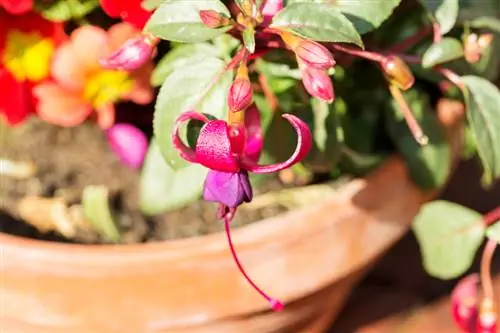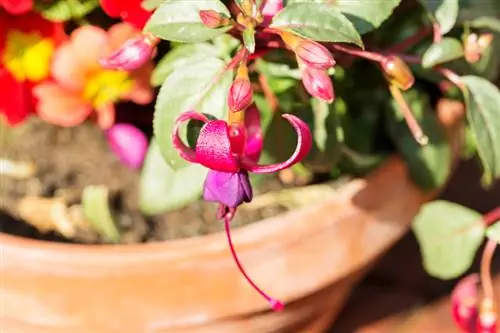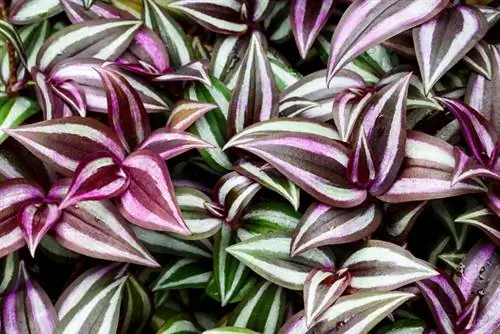- Author admin [email protected].
- Public 2023-12-16 16:46.
- Last modified 2025-01-23 11:20.
Like geraniums, fuchsias, which originally come from South America, are also typical balcony plants. The shrubs, which grow upright or hanging and are usually up to a maximum of 50 to 60 centimeters high, are striking for their distinctive, often two-colored flowers. Fuchsias are also long-term bloomers that, if cared for well, show off their blooms throughout the summer and well into autumn.

How do I properly care for fuchsias on the balcony?
Fuchsias are ideal for shady balconies and require a moist, permeable substrate. Maintain them with regular watering, weekly fertilizing and good drainage in the pot. Since fuchsias are sensitive to frost, they should be overwintered in a cool, frost-free room in winter.
Location and substrate
Fuchsias are ideal for balconies that face west or east, meaning they have sun in the morning or evening, but not all day long. The plants come from the mountain rainforests of the Andes, where they thrive in the light shade of tall trees - accordingly, fuchsias are not sun-tolerant and should be kept in bright, but shady places. Conventional potting soil is suitable as a plant substrate, which you can loosen with clay granules (€15.00 on Amazon) (for example Seramis) and coarse sand. Fuchsias prefer a slightly moist, but permeable and moderately nutrient-rich plant substrate.
Properly care for fuchsias on the balcony
As typical rainforest plants, fuchsias like moisture, but cannot tolerate waterlogging. You should therefore ensure good drainage in the pot so that excess water flows away quickly and does not damage the roots. At the same time, however, fuchsias must not dry out, which is why the substrate should always be slightly moist. In addition, the heavy-feeding fuchsias need to be fertilized once or twice a week in a weak dosage. A liquid flowering plant fertilizer is suitable for this and is administered together with the irrigation water.
Fuchsias are not hardy
Unfortunately, fuchsias are very sensitive to frost and are therefore not hardy. For this reason, many balcony gardeners only cultivate their fuchsias over the summer and then throw them away in the fall. However, fuchsias can live for several decades and, if you let them, develop an interesting, gnarled trunk and woody branches with age. So it may be worth overwintering these interesting plants.
Winter fuchsias properly
Fuchsias should be cut back before the first frost and placed in a frost-free but cool winter quarters. This does not necessarily have to be bright because the plants shed their leaves in autumn and can therefore overwinter in a dark cellar, stairwell or attic. Place fuchsias in their winter quarters as late as possible and back outdoors as early as possible. In winter, fuchsias are not fertilized and are only watered sparingly.
Tip
In winter quarters, temperatures between five and ten degrees Celsius are ideal.






